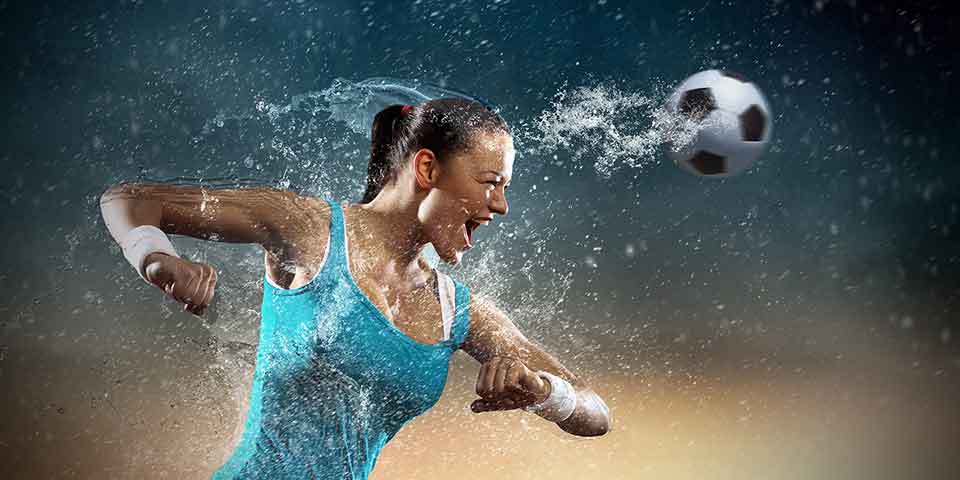The rise of women’s sport
International Women’s Day was celebrated on 8th March, 2020. Its aim is to celebrate women’s achievements and increasing visibility, while calling out inequality. In the sporting world, their mission is to celebrate women athletes and applaud when equality is achieved in pay, sponsorship and visibility. In our blog this week, we take a look back at the history of women in sport, how far it has come and what obstacles it faces in the future.

History of Women’s Sport
The origin of organized women’s sport can be traced back to the 6th century B.C. Although the ancient Olympic games were initially organized in honor of the 12 Olympian Gods of Greece, 5 of which were women (Hera, Athena, Artemis, Demeter and Aphrodite), in the middle of the 6th century BC, the Greek government banned all women from any sort of participation in the competition. The ancient Greek women formed their own competition – ‘The Heraean Games’ which took place every year and involved only one event – the stadion – which was a running competition similar to the men’s event but 1/6 shorter. There are many key dates and many inspirational women who set standards and opened doors for many others along the way. We have listed just some of these to give an idea of how far women’s sport has come since the 19th century.
- 1842 – Ann Glanville formed a crew of four female rowers who took part in local regattas often beating the men
- 1866 – Vassar College in New York fielded the first 2 women’s amateur baseball teams
- 1884 – English woman Maud Watson won the first ladies singles title at Wimbledon and a few years later Ellen Hansell won the first women’s tennis US open
- 1896 – The first women’s collegiate basketball championship was played
- 1900 – 22 women (2.2 per cent) out of a total of 997 athletes competed in the Olympics for the first time over five sports (tennis, sailing, croquet, equestrian and golf)
- 1905 – The Camogie Association was founded in Dublin to organize and promote the women’s sport of camogie in Ireland and across the world
- 1921 – The Women’s Olympiad started the 1st women’s international event and was seen as an important step for women’s sport
- 1922 – The Women’s World Games, held in Paris in 1922 included the first regular track and field competitions for women
- 1969 – The English Women’s Football Association was formed
- 1972 – Title IX passed in the US stating that ‘No person in the United States shall, on the basis of sex, be excluded from participation in, be denied the benefits of, or be subjected to discrimination under any educational program or activity receiving Federal financial assistance’
- 1976 – Nadia Comăneci, won 3 Olympic gold medals at the 1976 Summer Olympics and was the first gymnast to be awarded a perfect score of 10 in an Olympic gymnastic event
- 1980 – Mary Decker was the first woman to run a mile under 4.5 minutes
- 1981 – The first women were co-opted to the International Olympics committee
- 1982 – The NCCA began sponsoring women’s basketball
- 1985 – The United States national soccer team was formed
- 1991 – A historic decision by the International Olympic Committee stipulated that any new sport seeking to be included had to include women’s events
- 1991 – FIFA (the Fédération Internationale de Football Association) began the Women’s World Cup
- 1996 – The Women’s National Basketball Association (WNBA) league was founded as the women’s counterpart to the NBA
- 1999 – Carolina Morace became the first female coach of a men’s professional soccer team in Italy
- 2005 – The organizers of the New York City Marathon announced they would be rewarding the female champion $130,000, that is $30,000 more than its male winner received. This may be the first time a sporting event ever paid more to a female than a male in the same competition
- 2012 – The London Olympics were the first games in which women competed in all sports on the program
- 2014 – Amélie Mauresmo, from France, became the first woman to coach a top male tennis player – Andy Murray
- 2014 – Michele A. Roberts was elected as the new Executive Director of the National Basketball Players Association, thus making her the first woman to be elected to the highest position of a major sport’s players association within the United States
- 2015 – Tickets for the Women’s Singles final of the 2015 US Open sell out faster than the Men’s final, a first in tournament history
- 2016 – At the Olympic games in Rio, in 2016 a new record was set with participation of women at 45%: 5,176 out of 11,444 athletes
- 2019 – 33% of International Olympic Committee members are women
- 2019 – Serena Williams is the only woman in the Forbes list of top 100 highest paid athletes
Challenges to gender inequality
Female participation in sport began a dramatic increase in the last quarter of the 20th century and the current rate of change is one of the major trends in the sport industry. But women who play sports today can still face many obstacles.
Speaking at the Women in Sport Summit in Melbourne last year, Kate Jenkins, the sex discrimination commissioner for the Australian Human Rights Commission, outlined a number of key challenges to gender equality in sport over the coming years. These include:-
- Equal Pay
- Support from Media and sponsors
- Participation at Grass Roots level
- Fan Engagement
- Facilities and Access
- Governance
- Respect
Fan engagement for women’s sport is higher than ever but the majority of female athletes are still working a second job and this has a huge affect on their preparation for high performance. Female athletes are often balancing work, training and travel. Experiences of women and girls at all level of sport is critical to engagement and the continued growth of women’s sport.
Irish born sprinter Phil Healy recently became Ireland’s fastest woman. Her record breaking run was witnessed by a sold out crowd at the AIT International Arena and streamed live on Irish television. This is the exception rather than the norm. In her own words
Kids sitting at home watching TV look up to male rugby players and GAA players. How are they supposed to get to know the female players if they’re not taken to matches or they don’t see it on television
Facilities and access are key challenges for women’s sport at all levels. Lack of sports clubs and facilities, changing rooms designed for men rather than women, scheduling games at times that don’t attract spectators – can all act as a deterrent to the growth of women’s sport. The boards of many sporting organizations are dominated by men and this can make it difficult for women to find a voice or make themselves heard. And last but not least – respect. Negative comments about women’s sports and athletics unfortunately still exist. They often promote outdated stereotypes that don’t belong in the modern world.
Taking on gender inequality
In March 2019, the US Women’s National Team filed a gender discrimination lawsuit against the US Soccer Federation. In terms of success, the US women in recent times, have won 4 World cups and 4 Olympic gold medals. The men failed to quality for the 2018 World Cup and their best achievement to date has been quarterfinals in 2002. In court this week, lawyers on behalf of the US Soccer Federation stated
WNT and MNT players do not perform equal work requiring equal skill, effort, and responsibility under similar working conditions
MNT have responsibility for competing in multiple soccer tournaments with the potential for generating a total of more than $40 million in prize money for U.S. Soccer every four years…WNT compete in only one soccer tournament every four years that has the potential to generate any prize money at all, and most recently that amounted to one-tenth of the amount the MNT players could generate.”
Coca-Cola, one of the sport’s largest sponsors, blasted U.S. Soccer calling the comments “unacceptable and offensive” and have requested to meet the federation immediately to express their concerns. On Wednesday, March 11th, U.S. Soccer President Carlos Cordeiro apologized for
the offense and pain caused by language in this week’s court filing, which did not reflect the values of our Federation or our tremendous admiration of our Women’s National Team. Our WNT players are incredibly talented and work tirelessly, as they have demonstrated time and again from their Olympic Gold medals to their World Cup titles
The next hearing in the case is scheduled for March 30 and the case is set to go to trial in early May.
The future
Despite all the obstacles, the future for women’s sports does look bright and there are so many more opportunities for young women in sport than there were even 10 years ago. Women’s sport has started to thrive even without fully funded systems and infrastructure. The FIFA’s women’s world cup in 2019 in France was the 8th women’s world cup in soccer. The final between the United States and Netherlands was the most watched match in Women’s World Cup history. According to FIFA data, the match received an average live audience of 82.18 million, up by 56% on the 2015 final.
In her article Sex, the World Cup and Breaking Up the Boys’ Club, Dr. Emily Ryall commented that
Great sport requires only three things: excellence of skill, uncertainty of outcome and a crescendo of drama until the last second. Gender or sex is irrelevant
Organizations such as the Women’s Sports Foundation(set up in 1974 by Bille Jean King) and more recently the 20×20 initiative aim to create a cultural shift in our perception of girls and women in life and sport.
This isn’t a ‘women for women’ initiative, it’s ‘all of society for all of society’. If sport is good, which we know it to be, then more sport is better. If we all play, we all win. 20×20 is asking all sections of Irish society to show their stripes and pledge one small action to increase the visibility of women’s sport in Ireland because if she can’t see it, she can’t be it
About Metrifit
Metrifit is proud to support women’s sport and offers specific female tracking. Using Metrifit helps to provide deeper context to inform the decision making process, helping athletes perform at their best. Subjective wellness questionnaires along with player training load data helps drive professional conversation and actionable tasks to enhance the sporting results and quality of life for athletes and teams.
To find out more visit our Introducing Metrifit page or contact us at for a free demo.
Please share this post so others may benefit.
Follow @metrifit

References
Women’s sport: How the media are doing and how the media must improve
Key dates in the history of women in the Olympics movement
The History Of Women In The Olympics Is Inspiring by Caitlin Flynn
International Women’s Day is a time to recognise how far equality has come by Tanya Aldred
Getting over the line: Phil Healy on the challenges facing women in sport by Breda Graham
20×20: If she can’t see it she can’t be it
Sex, the World Cup and Breaking Up the Boys’ Club by Dr. Emily Ryall
Women’s World Cup: Record-breaking numbers
Record audience across the globe as 2019 Women’s World Cup watched by over 1 billion people
US Soccer claims it won’t pay women equally because being a male player requires more skill
U.S. Soccer Apologizes For Saying Male Players Have ‘More Responsibility’ Than Women
































 Previous Post
Previous Post Next Post
Next Post





